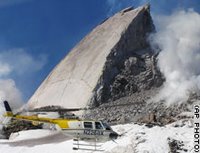 A huge slab of rock is rapidly growing inside the crater of Mount St. Helens in Washington state.
A huge slab of rock is rapidly growing inside the crater of Mount St. Helens in Washington state.Scientists say the fin-shaped mass is one of seven lobes of fresh volcanic rock that have been pushing their way through the surface of the crater since October 2004. It is growing 4 to 5 feet a day.
Mount St. Helens, located in the Cascades of Washington, has been quietly erupting since a flurry of tiny earthquakes began in late September 2004. Scientists initially mistook the quakes as rainwater seeping into the hot interior of the older lava dome.
But it soon became clear that magma was on the move, confirmed by the emergence of fire-red lava between the old lava dome and the south crater rim a few weeks after the seismic activity began.
The volcano has continued pumping out lava ever since. Eventually, scientists expect the volcano will rebuild its conical peak that was obliterated in the May 1980 eruption that left 57 people dead.
The current growth of the new lava dome has been accompanied by low seismicity rates, low emissions of steam and volcanic gases and minor production of ash, the U.S. Geological Survey said.
"Given the way things are going now, there's no hint of any sort of catastrophic eruptions," USGS geologist Tom Pierson said. "At any time, however, things can change."
Scientists flew a helicopter into the crater late last week to adjust equipment and take photographs that will likely be used to determine just how much the new lava dome has grown the last several months.
No comments:
Post a Comment